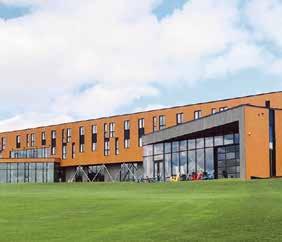
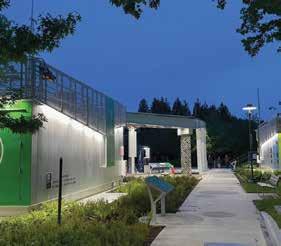



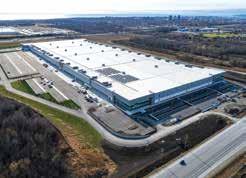
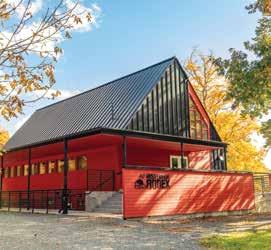

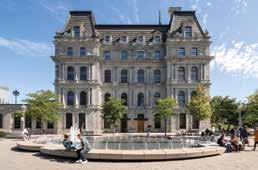
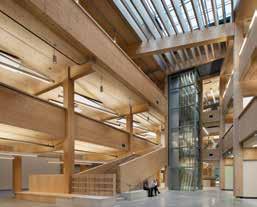
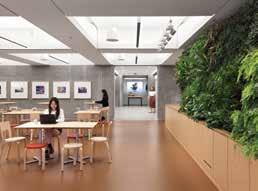












Proudly made in Canada with renewable energy, our low-CO2 gypsum solutions are an industry first from a brand architects trust. From Easi-Lite to GlasRoc, there’s something for everyone to love — today, tomorrow and beyond.






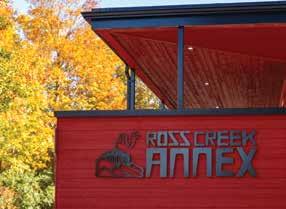
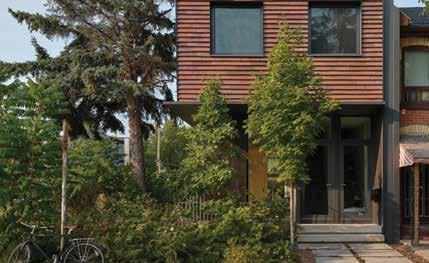


Innotech Windows + Doors is a Canadian manufacturer of high-performance windows and doors. The Defender 88PH+ System combines decades of fenestration knowledge to deliver a robust window and door system that is not only Passive House Institute certi ed, but that also delivers the air, water and structural performance required for highly sustainable housing developments.

Member Canada Green Building Council
SABMag is a proud member and official media partner of the Canada Green Building Council.
VISIT www.sabmagazine.com
Publisher Don Griffith
613-890-9634, dgriffith@sabmagazine.com
Editor Jim Taggart, FRAIC 604-874-0195, architext@telus.net
Senior Account Manager Patricia Abbas 416-438-7609, pabbas@sabmagazine.com
Graphic Design Carine De Pauw cdepauw@sabmagazine.com
Subscriptions/Change of Address Lyse Cadieux, lcadieux@sabmagazine.com
Published by www.janam.net Dedicated
Subscription prices for print [taxes extra]
1 year [4 issues] $28.95 $39.95 $84.95
2 years [8 issues] $50.95 $69.95 $148.75
3 years [12 issues] $74.95 $104.95 $219.85
Order print or digital: https://sabmagazine.com/subscribe/
ISSN 1911-4230
Copyright by Janam Publications Inc. All rights reserved. Contents may not be reprinted or reproduced without written permission. Views expressed are those of the authors exclusively.
Publication Mail Agreement #40024961
Return undelivered Canadian address mail to: Janam Publications Inc., PO Box 462 Stn Aylmer Gatineau, QC J9H 5E7
Printed on EQUAL Offset paper.

The winning projects in this year’s SABMag Canadian Green Building Awards clearly illustrate how our understanding of sustainability has evolved and diversified over the past several years, and confirm the degree to which this understanding has been embraced by the design and construction industry across Canada.
Reviewing the strong field of awards submissions, the objectives now informing our approach to design would appear to be:
• To put a greater focus on climate resilience; embracing social cultural and environmental considerations.
• To recognize the importance of strengthening the relationship between our built and natural environments, enhancing biodiversity wherever possible.
• To address the imperative of life cycle assessment, the conservation of embodied carbon and the advancement of circularity in construction.
• To realize the potential of buildings to have positive benefits on the health, happiness and wellbeing of all users.
• To address the challenge of affordability, through the use of factory prefabrication to improve productivity, speed up construction and reduce costs.
• Embrace technical innovation, particularly in the area of renewable energy, to decarbonize building operations.
This year, 11 projects were recognized by the jury, representing an unprecedented diversity of programs and scales, a variety of rural and urban contexts, and a geographic spread from British Columbia to Prince Edward Island.
It was inspiring to see how the design approach to each of the winning projects embraced several of the parameters listed above, not as a checklist, but as a well considered, holistic response to their unique physical, cultural and social context.
I would like to extend my thanks to the jury: Stephen Kopp of Acre Architects in Saint John; Michelle Xuereb of BDP Quadrangle in Toronto; and Shane O’Neill of Public Architecture in Vancouver. Their discussions were lively and informed; and their final choices reflected their desire for each winning project to convey an inspiring and transferable message of what is achievable in each construction sector.
In addition to congratulating the project teams for their winning entries and thanking all the other teams who submitted this year, we especially acknowledge the sponsors who enable us to host the awards program: our National Sponsor, the Canadian Precast Prestressed Concrete Institute, along with our Category Sponsors noted below.
Category Sponsors National Sponsor


The JWC8500 WINDOW SERIES from JELD-WEN® of Canada delivers a seamless fusion of style, performance, and energy efficiency—meticulously engineered to exceed expectations. The JWC8500 HYBRID option raises the bar across all Canadian regions, featuring a durable aluminum-clad exterior available in an exquisite range of colours.
A HYBRID WINDOW combines the strength and low-maintenance benefits of vinyl with the refined appearance of extruded aluminum. This protective aluminum exterior enhances durability and provides exceptional resistance to the elements, while maintaining the aesthetic appeal homeowners desire.

UP TO 22% BETTER ENERGY EFFICIENCY
26% LOWER PROFILE FRAME INCREASES GLASS AREA
LOW MAINTENANCE ANd LONG-LASTING
FULL EXTERIOR ANd BRICKMOULd COLOURS dUAL-PANE ANd TRI-PANE GLASS OPTIONS



Visit SABMag's Directory of Sustainable Products and Services for Sustainable, High-Performance Building where products are organized by Product Category and by LEED Category. Examples of featured listings include:

Galvanize Better
- Corbec is a pioneer for Sustainable Design and Construction by publishing with CSA the first EPDs in Canada for Galvanized Steel and the first EPD in North America for Galvanized Rebar. corbec.com

INLINE Fiberglass
- Our fiberglass windows and doors offer: Time-tested durability; Superior energy efficiency; Residential and commercial applications in LEEDcertified projects. INLINE Series 3000 windows are Passive House International certified. inlinefiberglass.com

International Timberframes - Our Wood100® DLT 100% wood, no glue stacked and cross laminated DLT panels make sustainable and energy efficient building products. itimberf.com
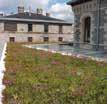
LiveRoof - LiveRoof is the premier prevegetated green roof system available across Canada. Regionally grown modules with vegetation specifically selected and tested for your climate by the horticultural professionals at LiveRoof. Wind uplift tested according to CSA A123.24-15. liveroof.com

Sapphire Balconies Ltd.T - The Prefab Balcony has a 19% CO2 reduction across stages A1-A5. Its lighter materials reduce building structure impact.
Safety is improved with the Remote Locker Device. balconies.global/ca

Fantech - Specifying made simple. BIM models and CSI 3-part specifications make it easy to spec quality residential and commercial ventilation products providing a healthy indoor environment where people live and work. fantech.net

MAPEI Canada - A leading manufacturer of chemical products for the building industry and has contributed to the construction of some of the most important architectural and infrastructure works worldwide. mapei.com

Radon Environmental Management Corp.
- High-performance radon mitigation solutions for commercial and residential builds, including Radon Guard™ ventilationinsulation structural panels and Radon Block™ barrier membrane. radoncorp.com

SIGA - A leader in the development and production of high-performance adhesive tapes and membranes for airand weather-tight building envelopes.
SIGA’s vision is a world with zero-energy loss buildings. siga.swiss/ca

Cascadia Windows & Doors - Highperformance fiberglass solutions for window wall, windows and doors, and storefront glazing. World’s first EPD report for windows using 2023 Product Category Rules. cascadiawindows.com

FABRIQ architecture
- FABRIQ architecture is a Montreal-based firm that delivers innovative and sustainable design solutions for clients across Canada. Several LEED projects are currently certified or underway. fabriq.com

Kohltech Windows & Entrance Systems
- Beauty and craftsmanship combined with performance and energy efficiency. A large selection of glass and decorative options, as well as ENERGY STAR and Passive House certified products to meet your project needs. kohltech.com

Silex Fiberglass Windows and Door
- SILEX offers energy efficient, Canadian made Fiberglass windows and doors that enhance building performance, cut energy costs, and promote sustainable construction practices. silexfiberglass.com

Forbo Flooring Systems - Marmoleum is CO2 neutral (from cradle to gate) due to natural ingredients that absorb carbon dioxide and a low energy production process, resulting in a sustainable floor that looks beautiful and lasts over 30 years. forbo.com

Join our FREE WEBINAR to learn how EcoSpex automates and digitizes your product environmental certifications in one platform for your customers.
There is demand from design and building professionals for easily accessed product information, product environmental certifications and sustainability data in a ‘one-stop shop’.
The webinar covers:
• Benefits of easily accessed Automated Documentation for your customers
• Demonstration of how construction professionals can use EcoSpex as a ‘one-stop shop’ to specify your products to achieve sustainability targets.
• See how the customer convenience of EcoSpex will increase your sales.
www.ecospex.com/event-list


www.ecospex.com
The SERRA apartments in downtown Montreal embody the future of sustainable development. Thanks to advanced green strategies, the project earned LEED v4 BD+C Silver certification in February 2024, proving that it is possible to combine performance and environmental responsibility.
Designed to minimize its carbon footprint, the building relies on efficient electromechanical systems, significantly reducing its GHG emissions. Its optimized engineering has resulted in annual energy cost savings of 26% while ensuring quality comfort for occupants.

Water, a precious resource, is managed with care: zero outdoor consumption thanks to native plants and a 30% reduction indoors with low-flow fixtures.
Beyond the numbers, it is quality of life that matters most. Abundant natural light, unobstructed views, optimized ventilation, and personalized indoor comfort control make SERRA Montreal a great place to live and work.
TST accompanied Vista Properties at every stage of the certification process, with a team of six sustainable building experts, all LEEDprofessionals in different specialties. Our rigorous approach ensures our clients receive a customized strategy aligned with the highest standards of environmental performance and energy efficiency.
TST is an essential performance partner where every project becomes an opportunity to build a more resilient, efficient, and eco-responsible future. Team up with us to certify your next building!

www.tst-inc.ca
Presenting and Lanyard Sponsor
Here’s to another successful Building Lasting Change – the conference where pivotal insights and actionable solutions help advance low-carbon, green and resilient buildings. BLC would not be possible without the support of our sponsors, speakers, volunteers and a endees.
See you next year in Montréal, June 17-19!
Plenary Sponsors



Technical Stream Sponsors

Showcase Station Sponsors



Executive Dinner

Prime Placement Sponsor
Gold Refreshment Sponsors


Conference Sponsors

Media Partners
cagbc.org/blc
Forum Sponsor

Ask The Expert


Super low U-values
Tough frames
Beautiful aesthetics
Passive house applications

SHOWN HERE
Fort St. John Passive House
Low Hammond Rowe Architect
RENU Engineering Inc.
WCPG Construction Ltd.
Thank you to our sponsors and jury!

Michelle Xuereb, B.E.S., B.Arch., OAA, LEED AP BD+C, CPHD Innovation Director, Americas BDP Quadrangle

Shane O’Neill, Architect AIBC
MRAIC LEED AP BD+C Director of Design & Associate Principal, PUBLIC Architecture + Design

National Sponsors
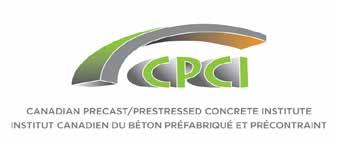
Category Sponsors

>> CONGRATULATIONS TO THE WINNING TEAMS FOR THEIR EXPERTISE IN DESIGNING THE PROJECTS FOUND IN THE FOLLOWING PAGES. >>
Stephen Kopp, AANB, NSAA, RAIC, LEED AP, Founding Partner, Acre Architects















University of Prince Edward Island, St. Peters Bay PEI

In terms of performance, this project was exemplary for its use of local materials including PH certified windows, which resulted in very low levels of embodied carbon. The program Is very progressive, integrating local Indigenous, Western, and global research communities within a collaborative, immersive 24-hour living lab environment.
Located in the village of St. Peters Bay this project is a living laboratory and educational destination, enabling world-class sustainability focused research and experiential learning for UPEI and its collaborating organizations.
The facility serves as a hub and activator for local community engagement. With its living-learning concept providing an immersive environment that includes active spaces for teaching, research, experimentation, socialization, and quiet spaces for personal contemplation and rest. The Centre also incorporates a multi-purpose community room with commanding views of Saint Peters Bay and Village.

The building extends east-west along the ridge of the hillside, accommodating parking to the north, enabling the creation of a wind protected southfacing courtyard, solar harvesting opportunities, while minimizing site disturbance. Existing vegetated hedge rows flanking the site were retained and reinforced.
Site plan
1. Sun path
2. Geothermal system boreholes
3. Solar panels arrays
4. Infiltration gallery and storm water retention system
5. Stormwater managment siteworks
6. Field access N
OWNER/DEVELOPER University of PEI, Province of PEI; Government of Canada
ARCHITECT Baird Samson Neuert Architects
ASSOCIATE ARCHITECT Sable ARC
GENERAL CONTRACTOR Bird Construction
LANDSCAPE ARCHITECT Vollick McKee
Petersmann & Associates Ltd.
CIVIL ENGINEER SCL Engineering
ELECTRICAL ENGINEER Richardson Associates Ltd
MECHANICAL ENGINEER MCA Consultants
STRUCTURAL ENGINEER SCL Engineering
PHOTOS Brady McCloskey Photography
The Centre’s ‘think globally, act locally’ sustainability approach is rooted in local supplier and trade capabilities wherever feasible and available. Examples include the use of all-wood, carbon sequestering construction using locally sourced stick-frame construction, gluelaminated columns/beams in fire/exposed locations (and the selective use of steel where dictated by economy/maintenance and durability considerations), locally assembled/ prefabricated wood wall panels, regionally harvested wood cladding and locally manufactured Passive House Certified windows which are manufactured within the LEED V4.1 ‘local’ radius of 160km from the site.


Floor plans
Collaborative Spaces
1. Drone Port + Workshop
2. Studio
3. Laboratory
4. Meeting Room
5. Gallery / Collaborative Research / Indigenous Gathering
6. Resource Room and Kitchen Offices
7. Private Office Residences
8. Two Bedroom Unit Lounge
9. Rooftop Terrace
10. Lounge Rooftop Terrace
11. Service space




These local and regionally sourced materials (within 400Km) account for 20% and 65% of overall costs, respectively. The holistic design approach embeds sustainability outcomes through siting, daylighting of interior spaces, cost-effective carbon-sequestering wood stick construction, enhanced envelope design and by its all-electric concept that incorporates ground source geothermal and on-site renewable energy generation, using a 100kW solar array to offset embodied and source 2 carbon emissions.
While not formally certified under CAGBC’s Net Zero Carbon standard, the project is incrementally tracking towards realizing a holistic net zero carbon and net zero energy outcome. As noted above, the project’s sequestered carbon approach includes the extensive use of wood; its renewable energy supply is all electric; while
and
carbon-sequestering, enhanced
of the
and by its all-
its high-performance windows provide daylight, views and passive ventilation for regularly occupied spaces. Independently evaluated by a third-party shadow review process using the Athena Impact Estimator, embodied carbon exceeds the Zero Carbon Building Design V3 benchmark by 59%.
The Total Energy Use Intensity (TEUI) is modelled at 109.6kWh/m2/ year, higher than might be expected for a post secondary education facility of this kind. However, this figure reflects the unique 24-hour live-learn operational cycle that significantly increases the overall energy demand.
This project demonstrates that design excellence, high-performance sustainable design and affordability can coexist. Its all-electric systems approach, low-embodied carbon structure, and high-performance envelope together achieve a zero-carbon design and create a pathway for a net-zero energy future.




A very valuable and beautifully executed example of the preservation, upgrading and repurposing of a building typology familiar in many small communities across Canada. Also notable were the diversity of activities the building now supports and the decision to make accessibility central to the design, by relocating the entrance ramp to the front of the building.
The Ross Creek Annex is a music and foodfocused community venue in the village of Canning, Nova Scotia, designed for Ross Creek Centre for the Arts as well as the larger surrounding community.
The project is a deep-energy retrofit of the previously decommissioned St. Lawrence Church. The main church hall is transformed into a flexible music performance space that can also be used for a variety of events and gatherings. The building also houses a new recording studio, multi-purpose room and community kitchen on the newly accessible lower level.




1. The owners had a clear desire to convert the decommissioned St Lawrence Church to a new, welcoming and accessible venue for the local community.
2., 3. and 4. The decommissioned St Lawrence Church before the renovation; during upgrades to the exterior envelope including EPS insulation to eliminate thermal bridging; and the completed project.
Premier Metals supplied the durable standing-seam metal roofing and cladding.
The most significant sustai ng new, saving 26.9 tonnes of carbon emissions by extending the life of the existing structure. The upgrades to the exterior envelope, which include additional insulation, a new airtight weather barrier and new triple pane windows, lower energy consumption and increase occupant comfort.
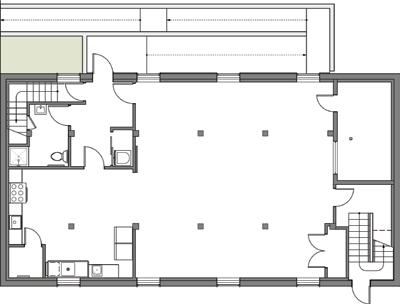

Converting the HVAC system from oil to electric with new heat pumps and high efficiency ventilation system was a future-proofing, carbon reduction strategy, while installing solar PV panels on the roof offsets overall building energy use by 50%. N
Floor plans
1. Multi-purpose room
2. Recording studio
3. Community kitchen
4. Bathroom
5. Lower vestibule
6. Community hall
7. Main vestibule



This church was ideal, accommodating the program without an addition, so the surrounding forest could be maintained. The layout of the existing church with its large, open nave space and additional space in the basement was well set up to be converted into community gathering spaces with minimal changes.
Extending the life of the existing structure also reduced construction costs while saving a beautiful historic building, much loved in the community. The design works within the constraints of the existing building to maximize passive design strategies. The south-facing orientation optimizes solar heat gain and the efficiency of a solar PV array.
OWNER/DEVELOPER Christopher Peck and Joan Powell for the Ross Creek Centre
ARCHITECT Solterre Design
GENERAL CONTRACTOR Cripple Creek Carpentry
ELECTRICAL ENGINEER Emtech Consulting Engineers Ltd.
MECHANICAL ENGINEER M. Lawrence Engineering Ltd.
STRUCTURAL ENGINEER Andrea Doncaster Engineering
PHOTOS Acorn Art & Photography, Memo Calderon
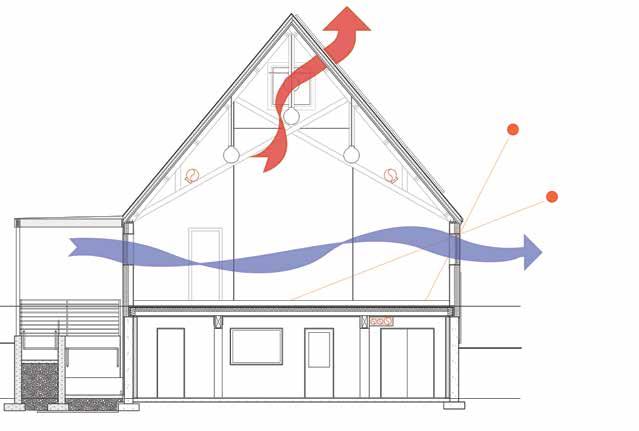
On the main floor, the community hall is a large open, brightly lit space with a stage at one end. Lighting and sound equipment are effectively placed for an ideal performance setting. It encourages community interaction as the perfect space for all types of gatherings and events hosted by Ross Creek or other groups who wish to rent the space.
Multi-purpose room
Community hall
Cross ventilation
Exterior ramp
Solar panels 6. High motorized window for venting summer heat
Summer solstice
Winter solstice
Concerts, music workshops, kids programming and community suppers encourage movement, social interaction and healthy eating, supporting the physical and psychological wellbeing of participants.
This deep energy retrofit, with its heat pump heating and cooling system, have transformed a once seasonally uncomfortable building to one that is regularly used for yoga, martial arts and other fitness classes on both levels – a success story for the community.

The jury appreciated the thoughtful integration of this facility into the public realm of the campus, a beautiful example of an emerging typology, and a welcome departure from the traditional gas station. As a highly visible urban amenity, it is a great catalyst for energy innovation and education.

Site plan
1. Hydrogen storage container
- hydrogen storage cylinders
- compressor module
- concrete pad with 3m safety zone
- vinyl wrap graphic surface treatment
2. Electrolyzer container
- electrical room
- electrolyzer
- supporting equipment
- vinyl wrap graphic surface treatment
3. Bioswale / detention basin
- filters discharge water from electrolyzer process
- retains water for slow infiltration
- natural safety buffer
4. Vehicle forecourt / dispenser
5. Stormwater basin
- canopy runoff
- drains to bioswale / detention basin
6. New planting / vegetated barrier
- a natural barrier and setback zone planting of drought-tolerant planting
7. Existing deciduous trees
8. Concrete pathway
9. Existing bench
10. Existing pathway
11. Interpretive "education hub"
- infographic displays / panels
12. Existing underground utility vault

The hydrogen production and fueling station at UBC Vancouver campus is part of a ground-breaking, multi-phase clean energy initiative that serves as a model for what can be achieved on a standard city block.
Phase 0 includes an eHouse, providing critical energy management infrastructure. Phase 1 introduces the hydrogen station (this project), combining onsite hydrogen production, advanced storage, and fueling for passenger vehicles, transit buses, and fleet operations. Phase 2 adds a photovoltaic array atop an adjacent parking garage, integrating renewable energy into the project. The station’s design reflects a thoughtful, forward-looking aesthetic that seamlessly integrates with UBC’s urban and natural surroundings.
The architecture prioritizes user experience, with clear circulation pathways, intuitive functionality, and a welcoming appearance that invites community engagement with sustainable technology. Materials and finishes emphasize durability, safety, and sustainability, while incorporating natural elements to soften the facility’s presence within the campus.
Strategic design decisions for the hydrogen station were largely shaped by proximities to other campus energy infrastructure, as well as a parking garage that could accommodate a large photovoltaic array as part of the larger project considerations.


PROJECT CREDITS
ARCHITECT DIALOG
OWNER/DEVELOPER UBC Applied Science
GENERAL CONTRACTOR Turner Construction
LANDSCAPE ARCHITECT DIALOG
CIVIL ENGINEER Associated Engineering
ELECTRICAL ENGINEER DIALOG
MECHANICAL ENGINEER DIALOG
STRUCTURAL ENGINEER DIALOG
COMMISSIONING AGENT HTEC
CLEAN ENERGY TESTING Powertech Labs
PHOTOS UBC Applied Science
3. and 4. The architecture prioritizes user experience, with clear circulation pathways and a welcoming appearance.
5. Hydrogen reduces greenhouse gas emissions and supports clean transportation.
The site, previously an outdoor basketball court, was repurposed to capture a pedestrian desire line through the space, enhancing connectivity while integrating vehicle access and maintaining necessary safety clearances between equipment containers.
Placement of equipment containers aligns with existing campus pathways to support accessibility and efficient movement. Program organization prioritizes safety, functionality, and public engagement, ensuring user-friendly operations and educational opportunities.
The design delivers a recreational space into a functional, sustainable hub, advancing UBC’s climate goals and fostering innovation, collaboration, and community interaction. Landscaped areas, weather-protected zones, and interpretive displays educate visitors on hydrogen and renewable energy, transforming the station into a community asset.
Ample lighting and visible circulation pathways prioritize safety and accessibility, while rainwater management features celebrate the natural water cycle, blending functionality with sustainability. The rain chain manages runoff while poetically celebrating water, symbolizing the hydrogen production process. It enhances the facility’s aesthetics with the soothing sound of trickling water as it drains into nearby plantings.
The hydrogen fueling station at UBC integrates seamlessly into the campus’s district energy system, serving as a pivotal element in the transition to a low-carbon future. By producing and distributing green hydrogen, it reduces greenhouse gas emissions and supports clean transportation. Its design anticipates the decarbonization of energy systems by enabling scalable and flexible hydrogen solutions.
Beyond its immediate impact, the station serves as a launchpad for partnerships, business models, and spinoff ventures, providing a platform to demonstrate de-risked, scalable climate solutions. This forward-thinking project is a catalyst for innovation and aligns with long-term goals to eliminate reliance on fossil fuels.



With its solar chimneys and water walls, this four-storey office building was notable for its innovative and highly visible environmental strategies. Its use of mass timber reduces embodied carbon, while creating an attractive work environment. The careful siting adjacent to the Black Creek ravine gives occupants easy access to the natural environment.




The TRCA Headquarters is a four-storey, 85,000-squarefoot mass timber office building. Serving as both an administrative centre and a learning hub, the facility offers a highly flexible and collaborative work environment, featuring open workspaces, private offices, meeting rooms, and adaptable areas with movable partition walls.
The design of the headquarters prioritizes passive systems by utilizing Passive House principles, which include a high-performance building envelope and solar optimization for natural daylighting and ventilation. The mechanical systems feature an open loop geo-exchange system connected to a modular heat recovery chiller that supports radiant heating and cooling panels located at the ceilings for efficient temperature regulation.
The facility incorporates energy recovery ventilation (ERV), highlighted by four "water walls" in the main atrium. These water walls are glass enclosures where ventilation air is pulled down from the roof intake and distributed to ERVs.
CLIENT The Toronto and Region Conservation Authority
ARCHITECT ZAS Architects + Interiors and Bucholz McEvoy Architects (Dublin)
STRUCTURAL ENGINEER RJC
CIVIL ENGINEER TYLin (previously TMIG)
MECHANICAL ENGINEER Introba (previously Integral)
ELECTRICAL ENGINEER MBII
ENERGY EFFICIENCY CONSULTANT
LANDSCAPE ARCHITECT Schollen & Company
CONSTRUCTION MANAGER Eastern Construction
PHOTOS ZAS Architects

2. The thermally-broken curtainwall borders the interior workspace areas for plenty of natural light. The Tremco ExoAir impermeable air barrier mitigates air infiltration/exfiltration, vapour transmission and water penetration.
Radiant ceiling panels heating or cooling mode permitted under certain conditions
Air from spaces is pulled in and out of atria into solar chimneys
Motorized blinds monitored and controlled by the Building Automation System (BAS) reduce solar radiation on south facade when it exceeds 200W/m2

Typical floor
Inside each glass duct, a chain-link mesh is suspended the full height, with cascading water providing both a visual display and a role in pre-heating and humidification of the dedicated outdoor air HVAC system.
Together, these systems contribute to energy conservation, reduced greenhouse gas emissions, improved building performance, and comfort. The annual energy intensity for heating and cooling the building is estimated
Where double-skin facade is not employed, operable windows are used. When ENV conditions are met, the BAS sends an indication to computers, allowing occupants to open the windows. Triplepane low iron content glazing increases light penetration while low-emissivity coating reduces heat gain.
Fresh air is drawn into the building through openings in the preheat double-skin facade.
to be 61 kWh/m²/yr. Approximately 35% of the energy consumed comes from renewable sources, including on-site photovoltaics and a geothermal system. This all-electric building, designed in 2018, uses no on-site combustion for the operation of its systems.
Additionally, to reduce water consumption, the building includes rainwater harvesting for irrigation greywater reuse, and ultra lowflow fixtures. The projected potable water consumption for the building is 40% less than that of the reference building.

Life cycle issues were incorporated into the design approach of the TRCA Headquarters, including designing for the anticipated service life of the building. Measures taken to ensure flexibility in use, such as modular access floors and adaptability to other functions, and demountability and recyclability of building components include the use of modular construction and durable materials. The building is designed to last 100 years and adapt to changing programs and technologies.
While the project is designed to be a sustainable office building with a strong focus on energy efficiency and environmental responsibility, its integration with the site was critical. The site design strategies work to preserve, rehabilitate, and enhance natural ecosystems. The approach includes groundscape, water management, planting, and habitat creation to integrate the building with the surrounding Black Creek ravine.
The project fits within the scale of a neighbourhood, community, and regional plan by promoting low- impact development and enhancing the site's natural heritage. The TRCA Headquarters participated in the CAGBC’s Zero Carbon pilot program and was designed to achieve TGS (Toronto Green Standard) Tier 4 criteria and LEED Platinum criteria.
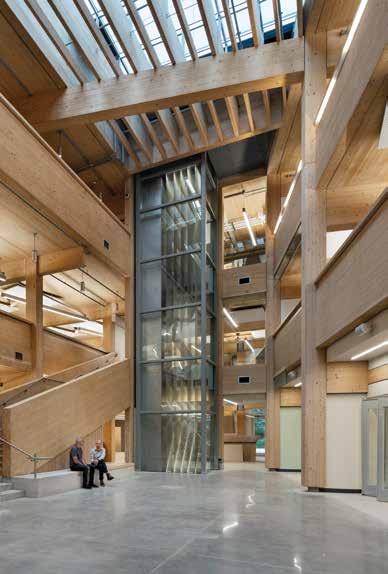









CONGRATULATIONS TO THE WINNING TEAMS OF THE 2025 CANADIAN GREEN BUILDING AWARDS. The annual program to recognize excellence in the design and execution of all types of sustainably-designed, high-performance Canadian residential and non-residential buildings and interiors, both new and renovated.

ZAS ARCHITECTS + INTERIORS AND BUCHOLZ MCEVOY ARCHITECTS (DUBLIN); AND INTROBA. COMMERCIAL INDUSTRIAL (LARGE) AWARD FOR THE TORONTO AND REGION CONSERVATION AUTHORITY HEADQUARTERS. (l to r): Merritt Bucholz, Karen McEvoy, Marek Zawadzki, Andrzej Gortat and Carmine Canonaco of ZAS Architects; and (l to r): Mike Godawa, Jamie Dabner and Jeff Phinney of Introba.

DIALOG. COMMERCIAL INDUSTRIAL (SMALL) FOR THE UBC SMART HYDROGEN ENERGY DISTRICT (SHED) – HYDROGEN GENERATION AND FUELING STATION. (l to r): Martin Nielsen and Kyle Bruce.

SOLTERRE DESIGN. EXISTING BUILDING UPGRADE AWARD FOR THE ROSS CREEK ANNEX. David Gallaugher.
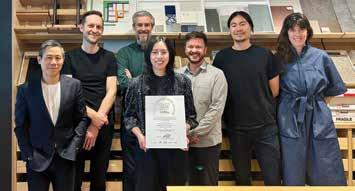
MONTGOMERY SISAM ARCHITECTS. RESIDENTIAL (LARGE) AWARD FOR THE HAMILTON PASSIVE HOUSE MODULAR HOUSING. (l to r): Daniel Ling, Jake Pauls Wolf, Enda McDonagh, Victoria Ngai, Kevin Hutchinson, Zheng Li and Sonja Storey-Fleming.

PURE INDUSTRIAL. COMMERCIAL INDUSTRIAL (LARGE) AWARD FOR THE LAKERIDGE LOGISTICS CENTRE. (l to r): Peter McFarlane, Jonathan Rovira, Rawan Khan, Lori Hipwell, Michael Duff and David Owen.

PERKINS&WILL. INTERIOR DESIGN AWARD FOR THE PERKINS&WILL VANCOUVER STUDIO. (back to front): Manuela Londono, Markus Brown, Rufina Wu, Cindy Nachareun, Naomi Tremblay and Amy Brander (on screen).

DIAMOND SCHMITT ARCHITECTS AND PHILIP AGAR ARCHITECT INC. INSTITUTIONAL (LARGE) AWARD FOR FANSHAWE COLLEGE INNOVATION VILLAGE. (l to r): Sarah Low, Amanda Van Amelsfort, Sydney Browne, Elcin Unal, Ewa Rudzik, Micheal Leckman. Missing from photo: Martin Gauthier, Kourosh Fathi, Michael Kim, Amy Norris, Christina Pascoa, Philippa Swartz, Jimmy Hung, Eva Xiao, Judith Geher, Nicole Wilke, Ronny Sepulveda, Michael Jess, Philip Agar, Andrew Ransom and Eric Shell, all of Diamond Schmitt Architects.

BEAUPRÉ MICHAUD ET ASSOCIÉS, ARCHITECTES IN COLLABORATION WITH MU ARCHITECTURE, NCK ET MARTIN ROY ET ASSOCIÉS. EXISTING BUILDING UPGRADE AWARD FOR THE HÔTEL DE VILLE DE MONTRÉAL/ MONTREAL CITY HALL. (l to r): David Gour, Nicolas Gautier, Antoine Cloutier-Bélisle, Camille Chabot, Patrick Ma, Jonathan Levesque, Menaud Lapointe, Nelly Charpentier, Maxime Bonesso, Camille Charest, Etienne Miloux, Sabrina Richardson, Catherine Lamarre, Pierre Beaupré, Josette Michaud, Jean-Daniel Mercier and Baptiste Aitken, all of Beaupré Michaud et Associés, Architectes.


SOLTERRE DESIGN. INSTITUTIONAL (SMALL) AWARD FOR THE NOVA SCOTIA NATIVE WOMEN’S ASSOCIATION ADMINISTRATION OFFICE AND RESILIENCY CENTRE. (l to r): Joshua Stromberg, Jennifer Corson and Keith Robertson.

BAIRD SAMSON NEUERT ARCHITECTS/WF GROUP. INSTITUTIONAL (LARGE) AWARD FOR THE CANADIAN CENTRE FOR CLIMATE CHANGE AND ADAPTATION, UNIVERSITY OF PEI. (l to r): Rana Alsharif, Madison Tousaw, Andrea Macecek, Jon Neuert, Sean March, Shannon Clark, and Corinne Barak.

CSV ARCHITECTS. INSTITUTIONAL (SMALL) AWARD FOR THE FOREST EXPLORERS OUTDOOR EARLY LEARNING CENTRE. (l to r): Alex Sargent, Richard Gurnham and Jessie Smith.




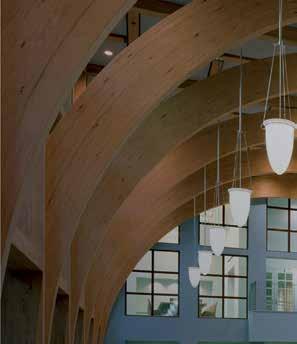














Transform sound into a design statement with Decoustics Fabric panels—versatile, fabric-wrapped wall and ceiling panels with superior noise absorption.
Choose from geometric forms, graceful curves, and rich colours, textures, and patterns. Or go bold with custom digital printing.
High-performance acoustic fabric panels that speak your design language.


Explore the possibilities.

Vancouver BC

This systematic approach to the reuse, reassembly and reimagining of existing furniture from a previous office is highly commendable; the more so because this facilitated the creation of a flexible and collaborative workspace to support employee wellness. The educational materials this process has generated are exemplary, as is the reduction in embodied carbon compared to new furniture. This project sets an example future clients will be encouraged to emulate.
B side Experimental Collaborative Curious Views to the city

Floor plan

A side
Client facing Focused Collected
Views to the mountains and water
After more than 20 years at its previous location, the Vancouver studio of Perkins+Will sought a new space that would allow it to embrace evolving workplace trends, and create an environment that would foster collaboration, flexibility, and employee wellness. To meet its goal of minimizing the embodied and operational carbon of the project, the team chose to rehabilitate space within and existing building.
An ideal solution was found in the iconic 26-storey Arthur Erickson Place tower, whose owners had recently retrofitted the building to CAGBC Zero Carbon Building Performance Standard™ and LEED Platinum certifications, consistent with P+W’s own green operations plan.
The challenge was to reorganize the program in a space that was 40% smaller than the previous studio; and only a single floor rather than multiple levels. Within these constraints, the aim was to maximize functionality, promote social interaction, collaboration and creativity.
The interior layout reinforces Erickson’s concept of ’two towers joined by a core,’ with the studio divided into two zones. The floor plan respects the 10-foot structural rhythm, giving the space an organizational rigour while allowing for areas of expression.
The social heart of the studio is the “living room”, a large open space that serves as café and kitchen, as well as a venue for casual meetings, lunch and learn sessions or weekly all staff seminars. The space also functions as a dynamic venue for events, gatherings, and meetings with community groups, industry organizations, and others.

3. The team chose to rehabilitate an office space within the 26 storey Arthur Erickson Place tower which was recently retrofitted to the CAGBC Zero Carbon Building Performance Standard™ and LEED Platinum certifications.
4. The social heart of the studio is the “living room” which serves as café and kitchen, as well as a venue for meetings and staff seminars. Wrapped acoustic wall panels by Decoustics reduce sound transmission.


The deeply recessed windows admit abundant natural light, supplemented when necessary by indirect light from the coffered ceilings. Daylight and glare analysis was conducted early in design, and workstations placed perpendicular to windows to limit glare. 74% of the regularly occupied floor area is within 6m of the windows, providing daylighting and views.
To minimize embodied carbon, the team took a circular approach to design. They selected material components and parts from the previous studio; reusing, reassembling or reimagining them for a wide variety of new applications, reducing embodied carbon emissions by more than 50%.
The original building was inspired by the work of Canadian artist Emily Carr, and so too are the warm earth tones of the studio, contrasting with the solemn grey exterior and making a visual connection to nature. The overall result is a flexible, wellness-focused workspace, showcasing innovation, efficiency, and sustainability. The project is RESET® Accredited and is on track to achieve WELL v2 Gold certification. It is also one of five projects featured in P+W’s newly-released Circular Design Primer for Interiors.

PROJECT CREDITS
ARCHITECT Perkins+Will
GENERAL CONTRACTOR Turner Construction
MECHANICAL/ELECTRICAL ENGINEER Smith + Andersen
STRUCTURAL ENGINEER RJC Ltd
FIRE PROTECTION MFPE
PHOTOS (INTERIORS) Ema Peter Photography
PHOTOS (EXTERIOR VIEW) Michael Elkan
5. Natural light is supplemented, when necessary, by indirect light from the coffered ceilings.
6. The layout reinforces Erickson’s concept of ’two towers joined by a core,’ with the studio divided into two zones.
7. To minimize embodied carbon, the team selected material components and parts from the previous studio, reusing, reassembling or reimagining them for new applications.



This project embodies a progressive vision of sustainability, cultural significance, and inclusivity. It achieves Net-Zero Operational Energy through passive solar strategies, a high-performance envelope, and rooftop PV. The focus on resilience, critical for all community buildings, is commendable; as is the seamless interweaving of Mi’kmaq cultural strategies into the architecture.
Designed using the “Two-Eyed Seeing” approach, this project uses the strengths of Mi’kmaq knowledge together with the strengths of western knowledge to create a facility that serves as a model for the design of sustainable Indigenous architecture.
From its inception, the project prioritized sustainability through its design and material selection. The facility achieves Net-Zero Operational Energy by employing passive solar strategies, a highperformance building envelope, and a rooftop solar photo-voltaic system. The NSNWA building is certified under the CAGBC Zero Carbon Building Design V3 standard.

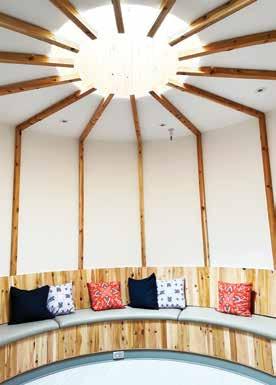
Floor plans
1. Lobby
2. Reception hall
3. Hub
4. Washroom
5. Photocopy
6. File storage
7. Recycling
8. Mechanical
9. Boardroom
10. Office
11. Staff area
12. Flex office
13. Cedar room 14. Knowledge room 15. Children's space 16. Healing centre 17. Wellness centre
18. Washroom
19. Maker space
20. Teaching kitchen 21. Storage

PROJECT CREDITS
ARCHITECT Solterre Design
OWNER/DEVELOPER Nova Scotia Native Women's Association
GENERAL CONTRACTOR Lindsay Construction Limited
LANDSCAPE ARCHITECT Outside Landscape Architects Inc
CIVIL ENGINEER Design Point Engineering and Surveying
ELECTRICAL/MECHANICAL ENGINEER Equilibrium Engineering Inc.
STRUCTURAL ENGINEER Andrea Doncaster Engineering Ltda.
COMMISSIONING AGENT Equilibrium Engineering Inc.
ARTIST COLLABORATORS Jennifer Denny, Jordan Bennett
PHOTOS Dean Casavechia
Creating a platform for meaningful engagement, and ensuring that the resulting design reflects the collective input and values of the Mi’kmaq women was fundamental to the design approach. Accordingly, the design team engaged elders, community members, and cultural experts to incorporate Indigenous knowledge and traditions into the architecture. Artists Jennifer Denny and Jordan Bennett were pivotal members of the design team, who inspired the references to the Mi’kmaq ribbon skirt and the traditional eight-pointed star pattern used on the exterior of the building. The collaborative approach has given the project cultural meaning and a sense of ownership within the community.


5
5. Outdoor spaces are connected via footpaths that continue into the Medicine Walk, including traditional medicinal plants. The civil engineering design by DesignPoint Engineering & Surveying Ltd. for site services, grading, and drainage emphasized preserving the natural landscape, enhancing stormwater management, and creating a sustainable foundation for a space connected to community and culture. Their work supported the project’s net-zero goals by preserving natural stormwater flows and minimizing site disturbance to protect the forested landscape.
The site was selected for its central location within the community between the commercial and residential zones. The placement of the building addresses the street and maintains the wooded lot behind, minimizing the impact on the natural environment, while maximizing connection to it.
Analysis showed that the existing forest cover enabled the site to absorb most of the rainwater. The site plan preserves stormwater flows, natural soil conditions and vegetated habitats, all of which create opportunities for land-based healing, learning and connection to the land. Outdoor spaces are connected via footpaths, that continue into the Medicine Walk, including traditional medicinal plants, and sweat lodge in the forest belt.
The children’s play zone incorporates naturalized surfaces, a rainwater riverbed and untreated wood canoe, fishing boat, drum circle and lodge play structures.
The building consists of two east-west oriented wings, offset in plan to create entry and playground courtyards, and to optimize solar orientation. The north wing houses offices and related spaces for NSNWA staff to support women and children; while the south wing houses the Resiliency Centre, which supports gathering and healing practices for Indigenous women, girls and 2SLGBTQQIA people and the wider community.
A central ‘Circulation River’ flows through the two wings illuminated by a series of skylights; the largest of which float above the central entrance lobby and reception area. In these areas’ cedar , a culturally significant material was chosen as the primary interior finish.







• A quick read every month
• Industry news and events
• SABMag Canadian Green Building Awards updates
• Highlights of past SABMag and regional FOCUS articles





A beautifully detailed example of a sustainable building that is treating its site carefully and lightly, providing an opportunity for future generations to learn through direct experience of nature. The milling of wood harvested from the site to create exterior siding offers children a visual and tactile message about sustainability.


This project redefines early childhood education by immersing 73 children, from infants to preschoolers, in a nature-filled environment. Located within Ottawa’s Greenbelt, this full-time daycare centre offers a year-round outdoor learning experience where children spend at least half their time exploring nature, rain or shine. The design embraces the principle of “learning through play,” fostering sensory awareness, resilience, and life skills through hands-on activities in a forested setting.
The Centre doubles as a research hub for Outdoor Play Canada, advocating for equitable access to unstructured outdoor learning. The facility, inspired by a “cabin in the wood”, integrates seamlessly with its environment.
Sustainability was a key consideration in the design, with a super-insulated, airtight envelope, high-performance triple-glazed windows, and bird-friendly glass. Regionally sourced, non-toxic materials were also used throughout.
PROJECT CREDITS
ARCHITECT CSV Architects
OWNER/DEVELOPER Andrew Fleck Children's Services
GENERAL CONTRACTOR Thomas Fuller Construction Co. Limited
LANDSCAPE ARCHITECT Lashley + Associates Corporation
CIVIL ENGINEERING Novatech
ELECTRICAL/MECHANICAL ENGINEER Goodkey Weedmark + Associates
STRUCTURAL ENGINEER WSP Canada
PHOTOS Kevin Belanger
2.


1. Main entrance
2. Forest entrance
3. Childcare greatroom
4. Cubby area
5. Infant room
6. Toddler room
7. Preschool room
8. Outdoor play area
9. Kitchen
10. Open workspace
11. Boardroom
12. Individual offices
13. Staff room
14. Staff balcony
15. Open to below
This environmentally conscious approach makes the Centre a model of low-impact design while creating a lasting educational facility that instills a lifelong love for nature in young learners.
Careful site planning maintains the existing topography and vegetation. The existing trees that were cleared for construction were locally kiln-dried and milled for use as building siding and custom furniture, while some logs were retained on-site to serve as seating and wildlife habitat.
The landscaping features strategic planting of native species, which support local biodiversity and regenerate the surrounding ecosystem. Stormwater management techniques promote water infiltration, minimizing runoff and enhancing groundwater recharge.
The building incorporates a high-efficiency HVAC system with energy recovery ventilators (ERVs) to ensure a constant supply of fresh air. Energy efficient LED lighting systems with motion sensors and daylight harvesting controls further enhance energy conservation.

Building section 1. Staff offices 2. Boardroom 3. Main entrance 4. Childcare greatroom 5. Outdroor play area
Light well
Staff balcony

The design of the Centre integrates both physical and psychological wellness through biophilic design elements and thoughtful material selection. The extensive use of wood throughout the space creates a warm, natural environment that helps foster a connection to nature and supports mental well-being. No- and low-VOC materials, along with formaldehyde-free finishes, ensure that indoor air quality remains optimal, further promoting occupant health. Large windows and open spaces offer visual access to the outdoors.

Communal spaces such as the wrap-around porch provide areas for social interaction, supporting a sense of community among children, parents, and educators. The outdoor learning spaces, forest classrooms, and nature trails are key to promoting physical activity and engaging children with the natural environment, encouraging exploration, creativity, and overall well-being.


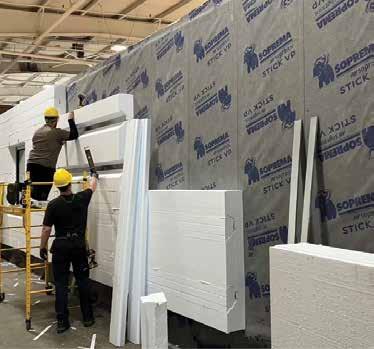



This project addresses issues of social, economic and environmental sustainability. A high-performance building, it reduces construction time and cost through systematized modular construction. The simple form, modest scale, material choices and elegant details fit seamlessly into its urban context. Careful placement and sizing of windows give the interiors a feeling of spaciousness and connection to the outdoors.
Located in downtown Hamilton, this project provides much needed housing for those who are experiencing or are at risk of experiencing homelessness. By transforming a former surface parking lot into a welcoming and dignified place to call home, the project demonstrates that equitable access to housing is indeed possible. The three-storey building accommodates 24 studio dwelling units along with shared amenities on the ground floor. These include a community room, meeting room, lounge, and laundry facility.

The enclosed backyard is animated with barbecues, seating, and a community garden surrounded by lush, lowmaintenance landscaping. Creating a building that was socially and economically sustainable for the client was a key driver for this project, as social housing operators require high-quality buildings that are durable, low maintenance and have low operational costs. By extension, this leads to environmentally sustainable design solutions.
Site plan
1. Main Entrance
2. Residence
3. Bike Shed
4. Rear Yard
5. Solar Panels
PROJECT CREDITS
OWNER/DEVELOPER CityHousing Hamilton
ARCHITECT Montgomery Sisam Architects
GENERAL CONTRACTOR NRB Limited - ATCO Structures
LANDSCAPE ARCHITECT OMC Landscape
CIVIL ENGINEER Ainley
ELECTRICAL ENGINEERING AND ENERGY
MODELLING Design Works Engineering
MECHANICAL ENGINEER Peel Passive House and Design Works Engineering
STRUCTURAL ENGINEER Solera and Design
Works Engineering
PHOTOS Doublespace / Younes Bounhar


Ground floor plan
1. Vestibule
2. Lobby
3. Rear Vestibule
4. Barrier Free Studio
5. Studio
Building section
6. Multi-purpose Room
7. WC
8. Meeting / Office Room
9. Laundry
10. Storage
Passive heating technology

Second floor plan
1. Barrier Free Studio
Studio 3. Electrical
Mechanical

Given the desperate need for housing, modular construction was used to accelerate the project timeline. This method also provided the benefit of reduced time and resources on site. Manufacturing and testing the modules within a controlled, indoor environment also supported greater quality control and high building performance.
On site renewable energy
Solar heat gains through glazing
High-performance envelope with R52 walls
Continuous air seal and thermal insulation around the extent of the envelope
No thermal bridging at junctions
High-performance windows
To minimize operating energy, the building includes:
• simplicity in massing and design, maximizing the interior volume to exterior surface ratio
• a highly insulated envelope, with R52 walls
• detailing that achieves superior airtightness of 0.3ACH at 50Pa, and minimizes the risks of thermal bridging and condensation
• an optimal window-to-wall ratio of 15.2%
The passive design approach is supported by active systems such as all-electric heating and cooling, which is partially offset by on-site renewable energy from rooftop PV panels which will generate 20,327 kwH/year. The building achieved Passive House Certification and has a TEUI of 62.7 kWh/m2/year, and a TEDI of 6.74kwh/m2/year.
The simple building exterior is free from unnecessary jogs or projections, making it easy to detail. The use of wood board and batten cladding provides a warm and friendly texture at ground level. Above this, metal cladding encompasses the building, giving it an elegant, uniform aesthetic.
The strategic placement of windows was a key strategy. A large 1.5m x 1.5m window was provided in the main living space, accompanied by a smaller 0.35 x 0.65m window adjacent to it. This ensures ample daylight and views while maintaining effective thermal performance.



3. Shared amenity space on the ground floor. Sun Glow Roller Shades in the building feature eco-sustainable technical textiles to filter natural light and moderate indoor temperatures, and equipped with a Fascia Valance for a contemporary aesthetic.
4. Living units have a large window accompanied by a smaller window for ample daylight while maintaining effective thermal performance. Ceramic floor tile used in many areas of the interior by Olympia Tile 5. The enclosed backyard has barbecues, seating, and a community garden surrounded by low-maintenance landscaping designed by OMC Landscape Architecture. Ground level cladding between the large windows is board and batten pattern from Marwood Cape Cod Siding.
The deep recesses of the windows are the natural result of the thick 15-inch exterior highly insulated wall assembly, resulting in deep shadows in every opening, giving depth and satisfying articulation to an otherwise very simple design.
The project aspires to remove the stigma around homelessness and social housing by gently inserting the residences into an existing urban setting, demonstrating that coexistence is achievable and beneficial for the community. The architecture reflects this by taking on an attractive form that blends in well and does not detract from the character of the established neighbourhood.
The CityHousing Hamilton project demonstrates how we can simultaneously address both housing affordability and climate change. It communicates that sustainable design isn’t just a moral imperative but an economic imperative as well.





Creating a central focus for the campus with a project that combines retention and new building was a strategic decision to support both environmental and social sustainability. The daylight and energy challenges posed by intensification were elegantly met with a day-lit atrium, clerestory windows and an innovative BIPV cladding system using active and passive solar panels.
Level one
1. Entrance Vestibule
2.
3.
4.
5.
6.

Innovation village includes the substantial renovation of existing facilities, minimizing new construction, demolition, and the carbon impact of the project as a whole. Additional floors of shell space increase density and the use of shared resources at the campus core. This contrasts with previous campus development, which spread horizontally across undeveloped land.
Student and Indigenous engagement informed the building’s design, visually and spatially, establishing a dynamic learning environment that supports diverse programming.
Glulam canopies at the main east entrance and south courtyard are warm and welcoming. Their seven columns reference the seven Indigenous teachings and the seven job skills of the future outlined by the College.
Level two
1. Canada Life Village Square
2. Studio
3. AR/VR Studio
4. Study Space
5. Multi-Use Classroom
6. Forwell Hall
7. Homework Lab

8. Meeting Rooms
The 11,800m2 Innovation Village project brings together previously disconnected interior spaces and courtyards to create a new heart for Fanshawe College. The design reflects Fanshawe’s focus on experiential learning.
Catering to the various ways people learn and collaborate, Innovation Village offers a variety of adaptable spaces that range from silent study zones to open work/study areas, homework labs to multi-use event and presentation spaces. It is a place where all students have access to innovative technology, including maker spaces, an augmented reality and virtual reality lab, multimedia labs, and Leap Junction – a centre for all things entrepreneurship – teaching both students and alumni the soft skills required to succeed in the changing workforce.
A new Library Learning Commons reflects Fanshawe’s commitment to inclusivity, and support for its more than 400 Indigenous students. It is home to the Kalihwíyo Circle (Oneida for ‘good message’) – the Indigenous Spirit Assembly. Its circular form creates a feeling of safety and trust, encouraging the sharing of culture.
2. In renovating the existing facilities and minimizing the amount of new construction, the architects added new space to increase density and the use of shared resources.

Its ‘turtle-shell’ ceiling references the creation of Turtle Island, while the floor and ceiling motifs represent the 28-day length and 13 repetitions in the annual lunar cycle. The space can host Indigenous workshops, exhibitions, and smudging ceremonies.
Forwell Hall is a flexible and open event space run by the Fanshawe Student Union that can be used for tradeshows, fashion shows, or as a student lounge. Opening to courtyards to the north and south, the Hall offers through views and features a two-storey curtain wall system supported by glulam columns.

New clerestory windows in double-height spaces bring daylight into all floor levels. Daylight sensors, energy efficient LED lighting and lighting controls reduce the energy consumption of the lighting system. The mechanical system uses high efficiency, cross flow air-to-air heat exchangers with low contamination.
Aside from providing safer circulating paths for air, they can recover energy from multiple sources of exhaust and incorporate this energy into the supply stream.
The exterior cladding includes custom-sized active and passive panels of PVD (Physical Vapor Deposition) coated glass installed on all four sides of the new tower, with active PV panels producing 120W-470W per panel.
OWNER/DEVELOPER Fanshawe College
ARCHITECT Diamond Schmitt in joint venture with Philip Agar Architect Inc.
GENERAL CONTRACTOR D. Grant Construction Limited
LANDSCAPE ARCHITECT Ron Koudys Landscape Architects
CIVIL ENGINEER Development Engineering (London) Limited
ELECTRICAL/MECHANICAL ENGINEER Smith + Andersen
STRUCTURAL ENGINEER VanBoxmeer & Stranges
COMMISSIONING AGENT WSP Canada Inc.
PHOTOS Tom Arban Photography
3. The Kalihwíyo Circle with its ‘turtle-shell’ ceiling can host Indigenous workshops, exhibitions, and smudging ceremonies. Tempeff dual core high efficiency enthalpy recovery units contribute to the energy efficiency of the building.
4. The cladding is composed of alternating upward-tilted active panels and smaller off-set passive panels.



Fresh air, lower energy costs, and extended HVAC life—all in one system. Tempeff DOAS, powered by our DualCore® technology, delivers reliable, highefficiency air management while supporting your sustainability goals.

Tempeff systems deliver 100% outdoor air while recovering energy, maintaining temperature control and ventilation with precision—even in extreme climates.
Our units are built with sustainability in mind—contributing toward LEED certification and enhancing building wellness with superior indoor air quality.
Saving
Reduced energy usage and a lighter load on your HVAC system translate into real operational savings over time, offering a lower total cost of ownership.



Wall section at parapet

1. Insulated parapet cap
2. Ventilation opening with perforated metal insect and bird screen
3. Vapour permeable, UV stable, weather barrier
4. Vapour permeable primary air and moisture barrier at parapet
5. 203mm mineral wool insulation
6. Thermally-broken stainless steel cladding clips
7. Horizontal aluminum cladding rails
8. BIPV junction box and optimizer
9. Solarlab BIPV cassette
10. Primary air, vapour, and moisture control membrane
11. Perforated metal insect and bird screen
12. Metal flashing
13. Electrical combiner box and conduit
14. Parapet cladding and insulation
15. 2-ply mod bit roof on sloped polyiso insulation
16. Steel deck on steel structure


The cladding is composed of alternating upward-tilted active panels and smaller off-set passive panels, creating a distinctive form for the new structure. This is estimated to provide approximately 18% of the project’s near-term power requirements, with a future rooftop PV array increasing this to 30%.

Montreal QC
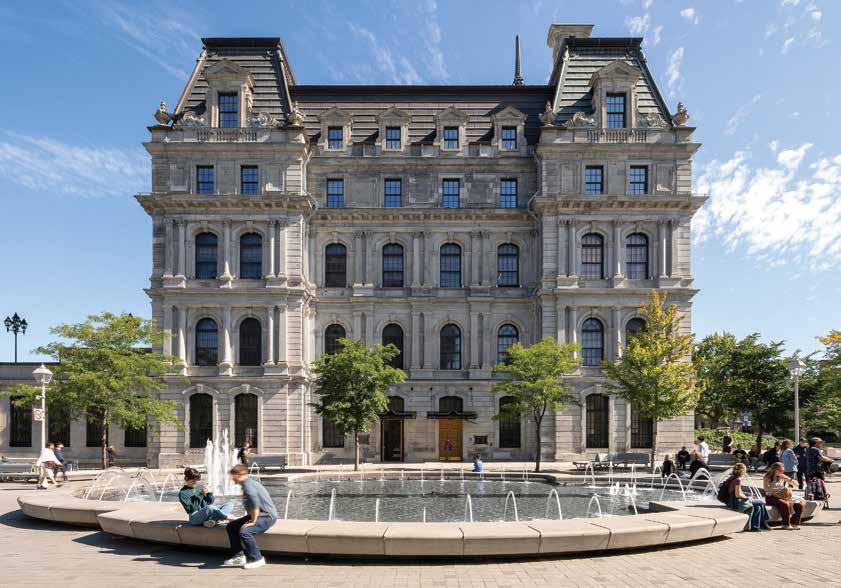
1. Built in the 1870s and rebuilt in 1925 after a fire, the Hotel de Ville is one of the largest heritage restorations undertaken in Quebec. Detailing incorporates Muntz Bronze from CBC Specialty Metals & Processing
Given the heritage status and historic character of this building, the performance metrics were highly commendable, proof that we don’t have to choose between preservation and sustainability. The process was comprehensively documented and the results are beautiful, simple, warm and modern.
The Hotel de Ville was built from 1872 to 1878 and rebuilt in 1925 after a fire. This project is one of the largest heritage restorations undertaken in Quebec.
The ambitious approach was aimed at preserving the exceptional features of the building, while introducing contemporary, open, and accessible spaces for citizens.
1. Vauquelin entrance
2. Gosford entrance
3. Welcome room
4. Exposition space
5. Coat of Arms room
6. Family room
7. Public cafe
8. Cloak room
9. Press room
1. Notre-Dame entrance
2. Hall of Honour
3. Council Chamber
4. Protocol Lounges
5. White Pine room
6. Terrace
10. Archives Consultation room
11. Registry Office
The strategic approach included: retention of architectural and structural components, preserving existing resources and avoiding the extraction of new ones; restoration of windows and upgrading of the building envelope to enhance energy efficiency; decarbonization of energy sources to achieve 99% carbon free operation; energy optimization through the recovery of heat from exhaust air and air-source heat pumps; and modernization of lighting, heating, and plumbing fixtures. These measures reduce energy consumption by 78% compared to its previous state. A LEED v4.1 O+M certification for existing buildings is underway, reflecting the emphasis on occupant quality of life.
Analysis of the 1925 plans revealed a design dedicated to civic activities. This principle has been updated, with public access points redefined, and the feeling of ownership reinforced by more inclusive spaces that meet the highest universal accessibility standards.



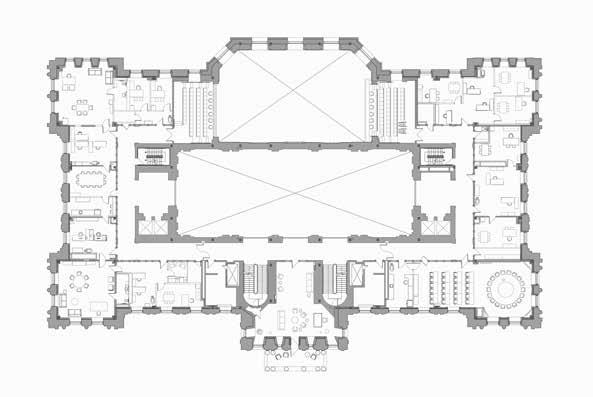

The redesign enhances the readability of interior spaces, allowing them to evolve over decades. Large axes serve as spatial landmarks and offer visual connections to the urban environment, letting light reach the centre of the building. The use of wood and biophilic elements strengthens the connection with the outdoors.
Alongside the restoration of the City Hall, the Champ-de-Mars to the north of the building has been redesigned to green the area and highlight the remnants of Montreal’s old fortifications. The site includes a 242 m³ retention basin for optimal rainwater management and a drip irrigation system that optimizes water use. These interventions help increase the site's resilience to heavy rainfall.
Restoring the 169 windows from 1925 is essential to the architectural identity of the building. They were meticulously disassembled and restored. A prototyping process tested the performance of the windows before restoration. Their air-tightness was improved by 75, comparable to new products rated A2 under the A440 standard.
The heritage lighting fixtures were restored and equipped with energy-efficient LED bulbs with optimized control. Motion detectors and programmed schedules reduce lighting consumption to 13 kWh/m²/year, down from 40 kWh/m² prior to the renovation.
City Hall operates entirely on electricity, eliminating fossil fuels and reducing GHG emissions by 99.6%. Its annual energy consumption is estimated at 98 kWh/m²/year, representing a 78% reduction.

Two thermal wheel air exchangers ensure efficient ventilation by adjusting air flow based on air quality. The air-to-water heat pumps use extracted air to improve energy performance. Water-to-water heat pumps facilitate thermal exchange, minimizing the need for additional heating or cooling.
Heating is provided by radiant ceilings for optimal comfort, while cooling and heating peaks are managed by individual fan coil units. All systems are integrated into a centralized management system, ensuring efficient operation and adaptability to future energy market challenges.
Wood was used to create a link between contemporary interventions and the restored heritage elements. Wood also provides soft textures, captures light, and diffuses it to create a gentle, cozy atmosphere.


PROJECT CREDITS
OWNER/DEVELOPER Ville de Montréal
ARCHITECT Beaupré Michaud et Associés, Architectes
JOINT ARCHITECT MU Architecture
GENERAL CONTRACTOR Pomerleau
CIVIL/STRUCTURAL ENGINEER NCK
ELECTRICAL/ MECHANICAL ENGINEER Martin Roy & Associés
COMMISSIONING AGENT CIMA+
OTHER CONTRIBUTORS David Gour; Plomberie Jubinville; HVAC; ACCS
PHOTOS Raphaël Thibodeau
4. The restoration preserved the exceptional features of the building while introducing open, and accessible spaces.
5. Natural light floods new workspaces supplemented by LED lighting equipped with motion detectors and programmed schedules. Heat pumps by Mitsubishi Electric Sales Canada contribute to improved energy performance.
6. The windows were meticulously disassembled and restored, with their airtightness improved significantly.


Although it is a significant percentage of our built infrastructure, the industrial sector is not often considered in discussions about sustainable design. Having achieved Net Zero Building certification and pursuing LEED Gold, this project provides a much needed, transferable example of what can be achieved.
Completed in December 2024, this is a 112,850 m2 industrial building, located adjacent to highway 401. The facility features a 12.2m clear height logistics area; over 200 truck level doors and more than 250 trailer parking spaces.
OWNER/DEVELOPER Pure Industrial
GENERAL CONTRACTOR TriAxis Construction Limited
ARCHITECT Glenn Piotrowski Architect Ltd.
DEVELOPMENT MANAGER Turner & Townsend Canada Inc.
CIVIL ENGINEER R.J. Burnside & Associate Limited
ELECTRICAL/ MECHANICAL ENGINEER Inviro Engineered Systems Ltd.
SUSTAINABILITY CONSULTANT Inviro Engineered Systems Ltd.
COMMISSIONING AGENT Inviro Engineered Systems Ltd.
STRUCTURAL ENGINEER Dorlan Engineering Consultants Inc.
TRAFFIC CONSULTANT TMIG /TYLin
EARLY WORKS (EARTHWORKS) CONTRACTOR Urgiles Brothers Excavating Inc.
LANDSCAPE ARCHITECT MHBC Planning, Urban Design & Landscape Architecture
GEOTECHNICAL + TESTING AND INSPECTION WSP Canada Inc.
ECOLOGY CONSULTANT SLR Consulting (Canada) Ltd.
PLANNING CONSULTANT The Biglieri Group Ltd.
2.The steel-frame building has a 12.2m clear height logistics area.
Setting a new precedent for industrial buildings in Canada, the project has achieved ZCB (Zero Carbon Building) certification and is targeting LEED Gold.
Using a holistic sustainable design strategy rarely seen in this building type, the project includes an electrified mechanical system, renewable energy solutions, advanced energy efficiency features and a thoughtful selection of materials to reduce operational and embodied carbon and support a healthy work environment.
The site is located close to transit; bike routes and a conservation area; promoting active transportation and offering opportunities for employees to engage with nature.
To minimize operating energy and enhance building performance, the design team opted for a highly insulated building envelope and paid particular attention to the design of the large dock doors. The envelope includes R-35 precast concrete lower walls, above which are R-40 insulated metal panels and an R-40 roof.
The curtain wall system is made up of double pane, low-e coated glazing units, complemented by R-20 insulated spandrel panels. Specialized dock door seals and vertical levellers minimize infiltration loss. The ultra efficient, electrified mechanical system incorporates ERVs and heat pumps to provide optimal ventilation and air conditioning for the warehouse. Stratification fans are strategically placed throughout the warehouse, redirecting heat from the ceiling to the occupied zone.


The warehouse is illuminated with high bay LED fixtures, controlled by occupancy sensors. These mechanical and electrical systems are managed by a centralized BAS (Building Automation System), ensuring efficient operation. Solar panels on the roof generate over 5% of the energy needs of the building; providing a clean and renewable source of electricity. The roof has been designed to be solar ready, enabling future expansion of the system.
Material selection was strategic; prioritizing locally available products which would have inherently lower embodied carbon. These ultimately represented 25% by value of the materials and products used in the project. These included the insulated metal wall panels, heat pumps and ERVs.


This strategy supports jobs and benefits local communities. Compared with a traditional concrete structure, the choice to use the insulated steel wall panels resulted in a reduction of 28% in the overall embodied carbon in the building.
In addition, the concrete used for the foundation has 30% recycled content. This reduces the demand for raw material and minimizes waste by repurposing industrial by-products.
TPO roof membrane on 13mm exterior sheathing
beyond
12mm asphalt impregnated fibreboard c/w dymeric caulking

Poured concrete slab on grade
50mm (R10) rigid insulation extend to 1220mm min. below grade

Prefinished metal flashing on pt wood blocking and plywood substrate
Steel girt
Insulate metal panel (imp) 125mm thick (R35) oriented vertically
Steel girt
Vertical structural support for o/h door track
Bracing supporting o/h door track on steel framing
Prefinished metal flashing
Precast wall panel 270mm thick (R35)
Loading dock canopy beyond
Cont. bent plate around precast opening, painted finish
Cont. weatherstripping at jambs & head
Insulated sectional steel door (R24)

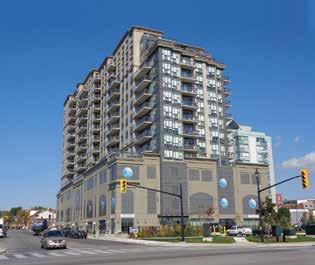
With Canada’s housing crisis, prefab precast concrete offers a powerful solution. It is faster, durable, and costeffective, as each component is made in a controlled environment. Prefab precast concrete offers superior quality, making it a resilient and sustainable approach to addressing Canada's mid to high–rise housing shortage.
Find out more about the benefits of using prefab precast concrete for your next project
Let’s build fast, affordable housing together!

For more information on affordable housing with prefab precast concrete, visit: www.cpci.ca/publications to download your free copy of the Structural Solutions Guide.
info@cpci.ca | 877.937.2724






































We pioneered the rst PVC-free wall protection. Now, we’re aiming for every 4x8 sheet of Acrovyn® to recycle 130 plastic bottles—give or take a bottle. Not only are we protecting walls, but we’re also doing our part to help protect the planet. Acrovyn® sheets with recycled content are available in Woodgrains, Strata, and Brushed Metal finishes. Learn more about our solutions and how we’re pursuing better at c-sgroup.com.







